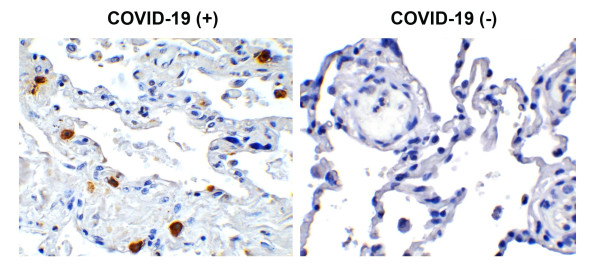ProSci
SARS-CoV-2 (COVID-19) ORF7a Antibody | 9283
- SKU:
- 9283
- Weight:
- 0 KGS
- Shipping:
- Calculated at Checkout
Description
SARS-CoV-2 (COVID-19) ORF7a Antibody | 9283 | ProSci
Host: Rabbit
Reactivity: Virus
Homology: Predicted reactivity based on immunogen sequence: SARS-CoV ORF7a: (90%) ; Bat coronavirus ns7a: (100%) .
Immunogen: Anti-SARS-CoV-2 (COVID-19) ORF7a antibody (9283) was raised against a peptide corresponding to 9 amino acids near the carboxyl terminus of SARS-CoV-2 (COVID-19) ORF7a protein.
The immunogen is located within the last 50 amino acids of the SARS-CoV-2 (COVID-19) ORF7a protein.
Research Area: Infectious Disease, COVID-19
Tested Application: E
Application: Antibody validated: SARS-CoV-2 (COVID-19) ORF7a antibody can detect 2 ng of free peptide at 1 μg/mL in ELISA. All other applications and species not yet tested.
Specificiy: N/A
Positive Control 1: N/A
Positive Control 2: N/A
Positive Control 3: N/A
Positive Control 4: N/A
Positive Control 5: N/A
Positive Control 6: N/A
Molecular Weight: 14kD
Validation: N/A
Isoform: N/A
Purification: SARS-CoV-2 (COVID-19) ORF7a Antibody is affinity chromatography purified via peptide column.
Clonality: Polyclonal
Clone: N/A
Isotype: IgG
Conjugate: Unconjugated
Physical State: Liquid
Buffer: SARS-CoV-2 (COVID-19) ORF7a antibody is supplied in PBS containing 0.02% sodium azide.
Concentration: 1 mg/mL
Storage Condition: SARS-CoV-2 (COVID-19) ORF7a antibody can be stored at 4˚C for three months and -20˚C, stable for up to one year. As with all antibodies care should be taken to avoid repeated freeze thaw cycles. Antibodies should not be exposed to prolonged high temperatures.
Alternate Name: ORF7a protein, Accessory protein 7a, Protein U122, Protein X4, ORF7a
User Note: Optimal dilutions for each application to be determined by the researcher.
BACKGROUND: Coronavirus disease 2019 (COVID-19) , formerly known as 2019-nCoV acute respiratory disease, is an infectious disease caused by SARS-CoV-2, a virus closely related to the SARS virus (1) . The disease is the cause of the 2019–20 coronavirus outbreak (2) . SARS-CoV-2 virus proteins include structural proteins, non-structural proteins and accessory factors. The structure of SARS-CoV-2 consists of the following: a spike protein (S) , hemagglutinin-esterease dimer (HE) , a membrane glycoprotein (M) , an envelope protein (E) a nucleoclapid protein (N) and RNA. SARS-CoV-2 non-structural protein is ORF1ab that consists of 16 proteins (nsp1-nsp16) , while accessory factors include ORF3a, ORF3b, ORF6, ORF7a, ORF7b, ORF8, ORF9b, ORF7a and ORF7a. ORF7a plays a role as antagonist of host tetherin (BST2) , disrupting its antiviral effect. It acts by binding to BST2 thereby interfering with its glycosylation. It may suppress small interfering RNA (siRNA) and may bind to host ITGAL, thereby playing a role in attachment or modulation of leukocytes (3) .
Additional Information
Clonality: |
Polyclonal |
Tested Applications: |
E |
Host Species: |
Rabbit |
Species Reactivity: |
Virus |
Conjugate: |
Unconjugated |





















